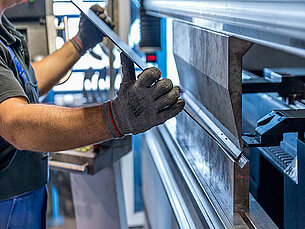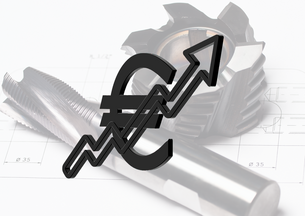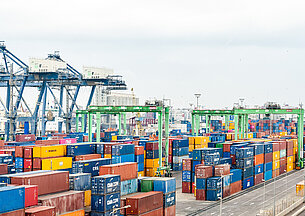The production of a component consists of several individual steps. First, after receiving the inquiry, a quotation is prepared for the customer.
Once the customer has ordered this, the actual process of manufacturing starts.
The producer is responsible for organizing the materials and delivery to the customer.
Complications (e.g. errors in production, etc.) can occur within these individual process steps of production.
In this case, the causes do not lie exclusively with the subcontractor, but in some cases with the customer.
Therefore, error prevention is more difficult than it first appears. If all persons involved in a production process work carefully
and communicate openly with each other, successful order processing is feasible. Why should a smooth process be strived for in the first place?
Quite simply, every delay costs unnecessary time and therefore money.
A distinction can be made between minor and major errors.
A small error would be, for example, a query from the producer about the order (missing material specification, error in the drawing).
In the case of a major error, the component is manufactured incompletely, for example. This results in a time-consuming complaint process (with return to the manufacturing company, rework and renewed dispatch to the customer). For this reason, it is precisely the major errors that should be avoided. The probability of these happening can be reduced as early as the classification of the drawing. If errors are already noticed when the request is processed, they can be corrected. This has the advantage that large errors do not occur. In this way, only as many resources can be used in the production of prototypes and small series as were originally planned. As a result, the production costs for the individual piece are kept within budget, which in turn benefits the customer. Additional shipments of goods are avoided, as there are no rework processes.
Before the start of actual production, the first difficulties may arise. Obtaining the materials needed for production can become a problem.
Due to the Ukraine war, bottlenecks in the supply of raw materials and materials, among other things, are increasing. Materials particularly affected are steel, plastics, wood, aluminum or copper. Raw materials are materials that are used to produce materials. Examples are iron ore the material from which steel or iron is made.
Furthermore, the Corona pandemic makes the procurement of materials and raw materials more difficult. During the pandemic, many companies had to cut back on production and required fewer materials/raw materials. However, demand for materials/raw materials will increase when the situation returns to normal.
This increase in demand is causing a shortage of raw materials at many companies. This is accompanied by delays in delivery, as the raw material is not available in time for the start of production.
The entire production is delayed. If the required material/raw material is not ordered on time, production may experience a shortage of raw material. The availability of the required material/raw material should therefore be checked at an early stage.
(ideally when the quotation is prepared).
Long delivery times for the material can thus be avoided.
Furthermore, companies should ensure that they have the necessary machine capacities. In the event of a machine breakdown, spare parts must be procured. This can the entire process into the long run.
Errors can also occur when preparing a technical drawing, e.g. if important details are forgotten.
For example, when dimensioning the component, a dimension line describing the dimension may not be present. Likewise, the dimension numbers or the dimension auxiliary lines may have been forgotten or drawn inaccurately. The dimension number defines the size of the dimension. Furthermore, tolerances may be missing, inaccurate or incorrectly specified. Thus, a caused deviation of the fit cannot be a direct error in the production, because the tolerances were not specified correctly by the designer. The lack of tolerances causes, for example, that the component does not fit in its intended place.
Special features such as holes, chamfers, threads, and radius should be identified and marking of elements not to scale should also take place to ensure accurate manufacturing.
If the correct unit of measurement (mm) has not been observed, values in the dimensioning may be too large or too small and the part will not be the required size. If the above-mentioned features of a production drawing are not observed or are entered inaccurately, errors may occur during component production or the component may not be produced. Therefore, each production drawing should be checked for completeness before the quotation is prepared. Small checklists can help here.
Effects of machine problems on production
When machine problems occur in production, they can lead to defective production of components.
Such machine problems include an unplanned breakdown of the machine (e.g. technical defect).
However, these problems can be prevented by regular maintenance and inspection of the machines.
The causes can be manifold. That is why production capacities should always be kept in mind. Many different errors can also occur during actual production:
The raw workpiece from which the component is to be created is clamped incorrectly. As a result, incorrect machining takes place and a workpiece is created as the end product that does not correspond to the drawing. Due to programming or reading errors, additional or incorrect drilling, threading or the like can accidentally occur during production. Another error occurs when the wrong material is accidentally used for the component. This material may have been intended for a different component. Human error is probably a common cause of such complications. However, some errors can be avoided through good planning and additional checks (e.g. checklists or dual control). However, factors such as staff absences due to illness or vacation should not be ignored either. This can lead to a delay in production.
- Components are packed incorrectly and damaged during transport
- Cartons tear open during transport and are sometimes lost in transit
- The shipment is mistakenly sent to the wrong customer (shipping labels are mixed up)
- The package is lost in transit
- Not all components are packed
- Components are damaged during packing (careful handling necessary, especially with sensitive surfaces)
- Lack of quality control (incomplete / defective components are shipped)
- Transport problems, due to strike of the parcel delivery company
Many of these problems can be avoided by small tips and attention. For example, the creator can check the production drawing for the presence of all information and for correctness before posting. Simple checklists, for example, can help here by checking the drawing for completeness.
In addition, predominantly European raw materials can be used in order to keep material costs low and not be affected so strongly by supply bottlenecks. In order to have enough raw materials for production, the keyword "material planning" helps. Enough material should be ordered (or availability checked) early enough so that running out of material during production is prevented. In addition, vacation planning should be coordinated with employees in advance so that production times and capacities are planned accordingly.
How PART FACTORY helps you
PART FACTORY helps to avoid many of the problems mentioned above. After setting the request, the manufacturing drawing is checked by our trained staff. We make sure that the data relevant for the production of your part is complete and correct. Subsequently, we pass the inquiry on to our network of qualified and tested contract manufacturers. Based on our experience in the past years, we are able to evaluate the incoming producer offers regarding price, delivery time and quality. In this way, your order goes to the producer who not only has the appropriate capacities, but also delivers reliably. Delivery delays cannot be completely avoided, but the frequency and duration can be reduced. In the last step, PART FACTORY makes sure that your components meet the high quality standards and have been manufactured to your satisfaction. After a quality check, the components are packed neatly and safely for transport. In this way, we prevent components from being damaged or lost during transport. PART FACTORY reduces to a minimum many possible sources of error that can occur within the manufacturing process. So you get your desired turned and milled part, from the hands of our CNC subcontractors.
Test our service!
Convince yourself of our uncomplicated service and make a production inquiry.
You will be surprised how little effort is required.
You can look forward to a high-quality prototype or a corresponding small series on the desired delivery date, which fully corresponds to your production drawing. Give it a try - it's worth it!


![[Translate to English:] PART FACTORY_Support [Translate to English:] PART FACTORY_Support](/fileadmin/_processed_/0/5/csm_PARTFACTORY-Direkter-Ansprechpartner-bei-der-Auftragsabwicklung_8a52cb72fa.jpg)
![[Translate to English:] PART FACTORY_Frästeil_5 [Translate to English:] PART FACTORY_Frästeil_5](/fileadmin/_processed_/e/3/csm_PART_FACTORY_Fraesteil_1_92aef51c26.jpg)
![[Translate to English:] PART FACTORY_Bauguppe_4 [Translate to English:] PART FACTORY_Bauguppe_4](/fileadmin/_processed_/a/c/csm_PART_FACTORY_Baugruppe_4_ded99b2b50.jpg)
![[Translate to English:] PART FACTORY_Zeichnung [Translate to English:] PART FACTORY_Zeichnung](/fileadmin/_processed_/3/3/csm_Baugruppen_a7ac82ab16.png)
![[Translate to English:] PART FACTORY_Drehteil [Translate to English:] PART FACTORY_Drehteil](/fileadmin/_processed_/f/a/csm_PART_FACTORY_Drehteil_1_c69ca595c6.jpg)
![[Translate to English:] PART FACTORY_Fertigung [Translate to English:] PART FACTORY_Fertigung](/fileadmin/_processed_/1/6/csm_PARTFACTORY_Cnc-Auftraege-direkt-von-PARTFACTORY_3185b6170a.jpg)
![[Translate to English:] PART FACTORY_Tipps für die Lohhnfertigung [Translate to English:] PART FACTORY_Tipps für die Lohhnfertigung](/fileadmin/_processed_/7/f/csm_PART_FACTORY_Tipps_f096488e30.png)





![[Translate to English:] PART FACTORY - Kontaktaufnahme [Translate to English:] PART FACTORY - Kontaktaufnahme](/fileadmin/_processed_/2/4/csm_woman-2773007__340_590260e0fe.jpg)